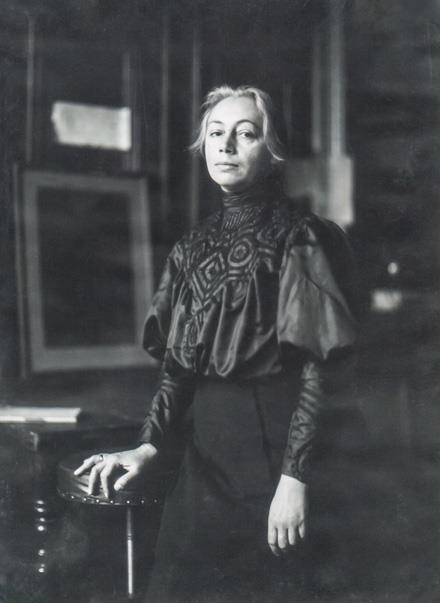
Käthe Kollwitz, 1906, Portray by Philipp Kester
(Estate Kollwitz, Käthe Kollwitz Museum Köln (c) Münchner Stadtmuseum)
Today, on July 8, 2024, Käthe Kollwitz would have been 157 years old
The world-famous artist was characterised by her socially critical commitment and her unmistakable individual style. To mark the anniversary of the graphic artist and sculptor’s birth, we are shedding light on the artistic talent of the sisters Käthe and Lisbeth and giving Käthe herself a chance to speak.
She was born Käthe Schmidt in Königsberg in 1867 into an educated middle-class family. Her artistic talent was recognised early on, as was that of her sister Lise (1870-1963). From the very beginning, her father supported and encouraged his daughters’ talent for drawing.
“Now my father had long realised that I had a talent for drawing, he was very happy about it and wanted to train me as an artist. Unfortunately I was a girl, but even so he wanted to give it his all. He reckoned that, as I was not a pretty girl, love affairs would not get in my way; and that is probably why he was so disappointed and upset when I tied myself to Kollwitz at the age of 17”, according to the autobiographical notes. (Diaries, p. 725f.)
Käthe received her first lessons in Königsberg from the engraver Rudolf Mauer (1845-1905) before she was allowed to go to Berlin for a year in 1886. She learnt the basics of painting in the painting class of the Swiss artist Karl Stauffer-Bern (1857-1891) at the painting and drawing school of the Verein der Berliner Künstlerinnen. When she returned to Königsberg, she took lessons from the painter Emil Neide (1843-1908). In July 1888, the Schmidt parents publicly announced the engagement of their daughter Käthe to the doctor Karl Kollwitz (1863-1940).
In 1888, Käthe went back to Munich for two years to study at the Künstlerinnenschule, where she was able to study nudes from a live model for the first time under Ludwig Herterich (1856-1932). From 1891 she lived in Berlin and in 1898 began teaching graphic art and drawing herself at the drawing school of the Association of Berlin Women Artists.
In her memoirs from 1923 and the “Rückblicken auf frühere Zeit” (“Looking back on earlier times”) from 1941, Käthe Kollwitz mentioned several times that she had considered her sister Lise to be at least as talented as herself in painting and drawing. Her father also saw Lise as an artist.
Despite her love for her sister, Käthe viewed her sister’s artistic work with unease and was visibly relieved when she married the engineer Dr Georg Stern (1867-1934), also from Königsberg, in 1893 and gave up an artistic career:
“I was hard-working and respectful, and my parents were delighted with every page. It was a happy time for father in this respect, we children were all in our formative years, Konrad wrote poetry and we performed his tragedies, I had an unmistakable talent for drawing and so did Lise. I remember once hearing my father say to my mother from the next room with great delight that we were all talented, but Konrad most of all. Another time he said something that I had to chew on for a very long time. He had seen a drawing of Lise that astonished him, so he said to my mother: Lise will soon have caught up with Katuschchen. That was perhaps the first time in my life that I felt envy and jealousy. I love Lise very much. We were very close, I allowed her to get ahead up to the limit where I started, beyond that everything in me resisted. I always had to have a head start. This jealousy never left me for years. When I was studying in Munich, there was talk of Lise moving there too. I had the most reluctant feelings, joy for her and at the same time the fear that she could overshadow my talent with hers and my person with hers, went back and forth in me. Incidentally, nothing came of her coming; she got engaged at the time and never received a thorough education.”
However, Käthe did not see her sister’s marriage as the only reason why she did not pursue an artistic career:
“If I now ask myself why Lise, for all her talent, didn’t become an artist in the true sense of the word, but only a highly talented dilettante, I now realise that. I was very ambitious and Lise wasn’t. I wanted to and Lise didn’t. I had a sense of purpose. In addition, of course, I was three years older than her. So my talent came to light earlier than hers, and my father, who was not yet disappointed, was more than happy to pave the way for me. If Lise had been tougher and more selfish than she was, she would undoubtedly have enforced her father’s consistent training. But she was soft and selfless (“Lise will always sacrifice herself”, said her father). Her talent was not developed in this way. She had at least as much talent as I did (…). She just lacked the perfect attitude towards it. I didn’t want to be trained in anything other than this. If I had been able to, I would have saved all my intellectual capacity and devoted it to my artistic ability so that only this fire would burn brightly.”


